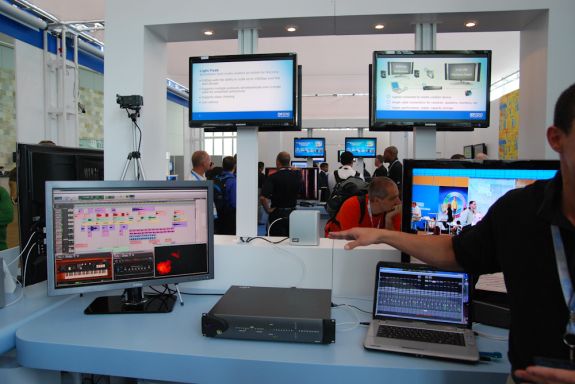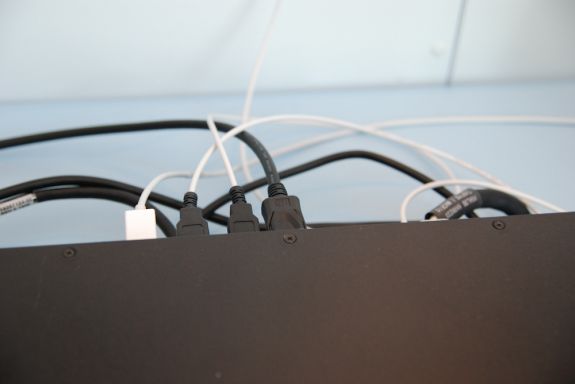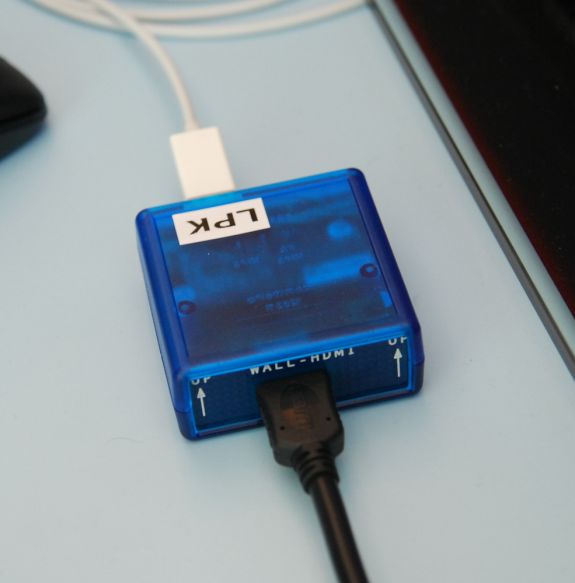Intel Light Peak - Lighting up 10 Gbps links in 2011
by Brian Klug on September 16, 2010 3:40 PM EST- Posted in
- Trade Shows
- Intel
- LightPeak
First off, Light Peak speeds remain the same as we've previously seen at 10 gigabits/s, though opportunity to scale to 100 gigabits/s remains a promise for the future. Intel had two demonstrations setup illustrating Light Peak's potential as a bus for huge amounts of traffic. First up was a Compal notebook connected to an Avid HD I/O box, which was in turn connected to two more devices. An external Western Digital dual drive solution with a Light Peak connector, and an HDMI adapter driving 1080P video content.
According to Intel, Light Peak enabled Avid to move mixing control to the Compal notebook software suite. Bandwidth is now sufficient to pass uncompressed extremely high sampling rate audio streams between the notebook and the Avid HD I/O box.
All of those white cables coming out of the Avid box on the left side are Light Peak. Note that they look a lot like USB - more on that in a moment. Light Peak connects the Avid HD I/O box and its lossless audio streams, a raw 1080P HDMI video stream, Western Digital external hard drive, and another uncompressed video played back on the Dell LCD to the left in this demo. This demo is clearly targeted at selling studio artists on Light Peak.
The Light Peak to HDMI converter box has also shrunk considerably. It's now a bit smaller in profile than a credit card:
There's no external power adapter here either, just Light Peak to HDMI for the TV. The Compal notebook has been shown around a bit before, but the connection is again seamlessly integrated into the notebook by all appearances. Check out the gallery for all the pics from this demo:



















59 Comments
View All Comments
gft74 - Thursday, September 16, 2010 - link
The article mentions that lightpeak is simply a transport. Does anyone know the feasibility of implementing say SCSI, or Firewire protocols on top of it?-gft
vol7ron - Thursday, September 16, 2010 - link
that shouldn't be hard, but really why would you want to?the real aim should be that external devices begin to have a light port.
Brian Klug - Thursday, September 16, 2010 - link
Because it's simply a physical layer transport, anything should work over it. SCSI, Firewire, you name it. I believe some of the only problems are making sure those protocols work at the respective speeds, but the physical Light Peak layer does allow bitrates that high.That's directly from intel, hopefully it doesn't change. They state they have no intentions of changing anything like USB, but rather using USB over Light Peak.
-Brian
cdillon - Thursday, September 16, 2010 - link
SCSI as a protocol (not the interface) is already used EVERYWHERE for mass-storage applications. Firewire, USB, FibreChannel, and SAS all use the SCSI command-set for mass-storage. I think by extension we can assume that Light Peak already speaks SCSI to some extent since it is meant to be, at the very least, a USB replacement.Did you know all modern CD/DVD drives actually speak SCSI? ATAPI == ATA Packet Interface, which transports SCSI commands over [S|P]ATA. This was a boon for both the CD/DVD drive manufacturers and software creators which had been using SCSI drives for years and years. With ATAPI, only the physical interface changed, not how you talked to the drives.
ATA, as a storage protocol, is really the "odd man out".
solipsism - Thursday, September 16, 2010 - link
Is the adapter receiving power from a cooper power wire from LightPeak source?holywarrior007 - Thursday, September 16, 2010 - link
It is bit disappointing that Intel keeps postponing these dates. First SB was going to arrive in Q42010 but now it will arrive in early 2011. Light peak was also going to arrive in Q42010 but it will come one year later. Intel has been, for whole this year, aggressively suggesting that it will come this year. Looks like folks at Intel can't keep any promise. A little competition to Intel is needed here badly.melgross - Thursday, September 16, 2010 - link
Intel has just said that we won't see any products until 2012 because the chipset won't be ready until late 2011.holywarrior007 - Thursday, September 16, 2010 - link
I know I read it somewhere too. But Intel has been saying for sometime that chipset would be available by Q42010 and products will after that. Now it will take one more year, which sucks. But this is not something new, Intel has recently delayed lots of deadlines. I wish if AMD has started offering USB 3.0 chipset then Intel would have hurried up with the Lightpeak.vol7ron - Thursday, September 16, 2010 - link
I rather see delays then products with complications.probedb - Friday, September 17, 2010 - link
Well they can either delay it and get it right or rush it out to make you happy and it could be full of bugs.I know which I'd prefer.